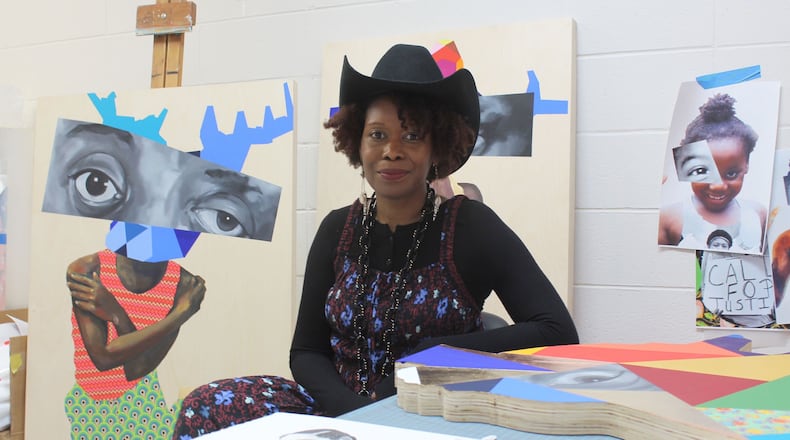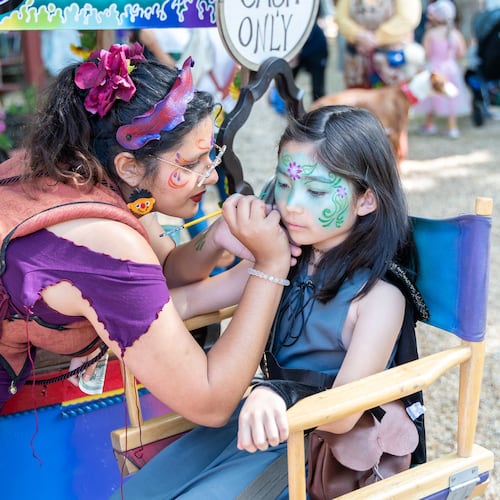Atlanta artist Shanequa Gay, 44, serves a look no matter what the occasion. Today, in her studio at the PushPush Arts complex in College Park, she’s sporting a black cowboy hat, cowrie shell earrings and a smocked, merlot and cornflower blue dress layered over a black shirt.
Her open, angelic smile and infectious laugh give her the energy of your favorite elementary school teacher, who validated and celebrated every creature in her orbit. Gay leads with an unapologetic sweetness rooted in a family life founded, she says, “to help, love and think about others.”
Behind that charm is a boundless work ethic and a brain that gallivants from the Atlanta child murders to organized religion, Gloria Steinem, bell hooks and the perils of social media, which she is trying to quit.
“We’re not built for this. The human psyche is not made for this much interaction,” she says, of the distraction that takes her away from what she really wants to do: create.
In her long, narrow studio not far from her East Point home, a portable heater keeps the chill out of the cinderblock space where she’s surrounded by the things that spark and inspire her: family photographs, paintings in progress and a list of ideas and inspiration rooted in her hometown.
In her eyes, Atlanta feels enchanted.
Gay’s artwork is “steeped in memory” and originates in her childhood experiences growing up in Atlanta: “Going to the Briar Patch (Greenbriar Mall) on Sundays for ice cream; concerts at Grant Park; riding in my daddy’s Bonneville down Oak Street to my grandmama’s house for fish fries; front porch sitters who always say ‘hey’ even if they do not know you; dope boys with manners; the Southern hospitality of being offered a cold iced sweet tea on hot Atlanta summers; watermelon after dinner; the So So Def billboard that used to hang over I-85 … and all things OutKast is what makes Atlanta magical.”
Credit: Shanequa Gay
Credit: Shanequa Gay
Hometown joy and heartbreak
No homegrown artist has ever celebrated the quirks, the culture, the strong vein of Black creativity running through the city in terms so endearing it makes your chest puff with pride.
Her “The Beautiful Tale of Atlannahland” collages, featured in a show at Jackson Fine Art last year, are exhibit A in Gay’s bone-deep Atlanta love.
The collaged works are a mix of various media including photography, paint and watercolor. And she often uses Photoshop and other graphic design tools to create colorful fantasias that blur the line between reality and make-believe.
Those “Atlannahland” hybrids feature little Black girls wearing “crowns” of Atlanta adoration festooned with what Gay calls “the joys of my childhood”: Rich’s Pink Pig, Now and Later candies, Lik-m-aid Fun Dip and Trappey’s hot sauce.
That edition, titled “Recovering Maynard,” sold out at Jackson Fine Art and grew her collector base to include Dallas Austin, alongside previous collectors Samuel L. Jackson, Michelle Obama, Los Angeles contemporary art collector Arthur Lewis, actor Charles Michael Davis and Elton John.
In “Atlannahland,” Gay combines playful imagery inspired by her childhood with elements rooted in African American and African identity. For instance, those headdresses made of Carmen Miranda piles of peaches, sunflowers, Hot Cheetos and grape soda are inspired by Ethiopia’s Mursi tribe, who wear elaborate headgear to express their personal style and identity.
“When I came up with this Atlannahland, I began to think about what I consider magical about the city,” says Gay, a graduate of Savannah College of Art and Design with an MFA from Georgia State University.
But she’s not the type to just herald her Atlannahland love. It wouldn’t be interesting without something deeper.
Look at the eyes in her collaged portraits, and unsettling elements come into focus. The little girls’ features are all baby fat chipmunk cheeks. But their eyes are ringed with sadness. Gay superimposed the eyes of the friends and families of Atlanta child murder victims and author James Baldwin, who wrote extensively about the murders, onto her figures.
The series came to her while watching children play in Perkerson Park several years ago and thinking about their absolute glee, which contrasted so sharply with the danger she felt lurking around the margins of her childhood.
“How my mother fretted for the safety of me and my brother,” she recalls.
That whiplash sense of childish joy and painful history interwoven in her body of work has elicited powerful reactions.
“There were people bursting into tears,” says Co-op Art Atlanta curator Courtney Bombeck, who presented the collages in a recent pop-up exhibition at the Buckhead menswear shop Maison Hideoki.
In another tribute to the city of her birth, the 2019 Hammonds House exhibition “Lit Without Sherman: A Love Letter to the West End,” Gay honored her granny’s Oak Street stomping grounds.
With nods to the pastoral tradition of toile and its quaint vision of country life, Gay replaced shepherds and milkmaids with the men and women of the West End — the Spelman undergrads, the pie-selling Nation of Islam, local heroes like artist Sue Ross and Andrew Young. In other words, a vibrant and vital community that may not survive the wholesale gentrification of this bastion of Black life.
But like the second line funeral celebration that reminds us you can’t have the trumpets and the dancing without somebody dying, “Lit” celebrates a dying slice of “Atlannah” that can’t be recovered once it’s gone. To get your Trader Joe’s and your historic bungalows with quartz countertops and open floor plans, someone or something is going to have to be displaced.
Credit: Shanequa Gay
Credit: Shanequa Gay
Questioning power imbalance
Gay was a Grady baby. She and her younger brother Cortez (her “best friend” who died in 2008 in a car accident) grew up in College Park until her family moved to Riverdale in the mid-’80s.
“We were like the third or fourth African-American family to move into the neighborhood where we lived. It was a culture shock to say the least.”
Growing up, her parents encouraged her to be creative. She drew, sang in the church choir, played the violin. There were no limits.
Her family was close-knit, and the house was filled with people and a feeling of community.
“There was always someone transitioning in and out of our home, or my cousins coming to stay, or my aunts and uncles coming to crash. The sleepovers were endless. I had to share my parents a lot growing up. They were stand-in moms and dads and mentors and guardians for so many.”
She attended the Cathedral of the Holy Spirit where the family worshiped with both Black and white congregants. Her mother was deeply religious. Her father, who worked in the trucking industry, was “extremely secular.”
After they divorced when Gay was 18, her mother married a pastor and earned a doctorate in divinity.
“I’m not as religious as my mother,” says Gay. “I do have a belief system. I do have spirituality.”
But growing up, she chafed against the way organized religion seemed to sideline women, devaluing their lives and their faith as somehow lesser.
“Because I grew up in a family of men who always built up and encouraged the women, I saw the contradictions in religion.”
She began to ask questions, like: “How are all the angels only men? Why aren’t women considered God-like and divine?
“Those questions led me into the work I do now,” she says.
In 2019 shows “ini-she-ation” at Chastain Arts Center and “The Devout Griot, Emotional Keeper” at Buckhead’s Anne O Art, Gay offered her own corrective to a church designed to prop up male power.
In sculptures, paintings and installations, she imagined women and girls as spiritual forces. Wearing deer and bull heads that obscured their identity, her female figures represented the power of the symbolic, the mythic.
The work, says Gay, was a response to Gloria Steinem’s observation that women and animals, formerly seen as deities in ancient religions, have been hobbled and neutered over time.
Gay’s work serves to restore and reclaim power, and central to that effort is the Black female.
That is what first captured the attention of curator Karen Comer Lowe, who included Gay’s work in exhibitions at Chastain Art Center and in the downtown public art exhibition “The South Got Something to Say.”
“She’s presenting Black women in these unique ways, but they are the main characters of the work,” says Lowe. “They’re the protagonists.”
Credit: Shanequa Gay
Credit: Shanequa Gay
Atlanta on a global stage
“What does it mean to carry the things that you are unaware of into the present and into the future?” asks Gay about the lingering impact of the Atlanta child murders that haunted her childhood.
“Most Atlantans will tell you that they do not believe Wayne Williams killed all those children. There is still this kind of ‘ick’ lingering over the city of something unresolved.”
That sense of unresolve runs through the new work Gay is creating for an exhibition called “Carry the Wait” at Syracuse University that continues the ideas of celebration and heartbreak of “Atlannahland.”
And in April, she’ll be featured in another exhibition, “Personal Structures,” presented by the European Cultural Centre (ECC) to coincide with the Venice Biennale. An international contemporary art event inaugurated in 1895, the Venice Biennale is essentially the Oscars of the art world. The ECC hosts a highly visible exhibition within the Palazzo Bembo, located on the Grand Canal where Gay’s work will be presented.
“I am floored and humbled, and I sway between tears and laughter,” says Gay of the opportunity to be part of such a prestigious event.
The timing seems right, as it coincides with a wake-up call to the nation — the world even — to stop dismissing the city as the poster child for “noplaceness” and urban sprawl, and recognize that “Atlanta Influences Everything,” as the city’s latest catchphrase states. That includes politics, social justice, film, music and, perhaps soon, the art world.
“I don’t think that all the stories that fill museums should only be Italian or Parisian or from Harlem or California,” says Gay.
She would like to see fine art in Atlanta reach the same heights nationally and internationally as hip hop has.
“How is it that rappers are not shunned if they talk about all things Atlanta,” while local artists have to be cagey about being based in the South if they want to be taken seriously by the larger art world, she asks.
“When I speak about who I am and where I’m from and I have pride in that — to put that in my work can be seen as problematic. Why is that? Why haven’t we changed that narrative?”
Shanequa Gay is still asking questions.
About the Author
The Latest
Featured




